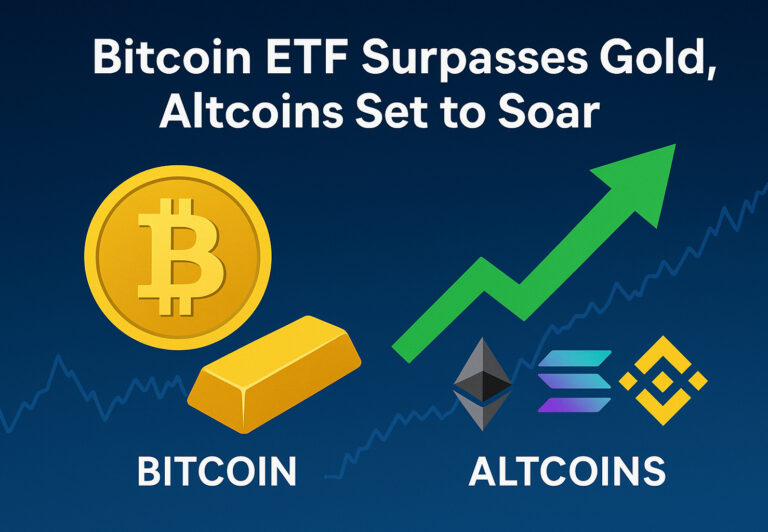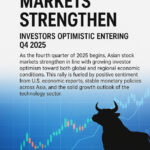Premium Biz Post – The cryptocurrency market is undergoing a significant transformation as Bitcoin ETFs are now approaching and even surpassing gold in terms of total assets under management (AUM). This milestone signals a shift in investor confidence and highlights how cryptocurrencies are increasingly competing with traditional safe-haven assets. Bitcoin ETF Surpasses Gold, Altcoins Set to Soar is no longer just a headline—it reflects a growing financial reality in 2025.

The Rise of Bitcoin ETFs and Investor Confidence
Bitcoin Exchange-Traded Funds (ETFs) have captured immense attention from institutional and retail investors. The launch of spot Bitcoin ETFs in major markets has simplified crypto exposure, offering regulated access while eliminating the complexities of wallet management and self-custody. As of September 2025, Bitcoin ETFs collectively hold more than $160 billion in assets, narrowing the gap with gold ETFs, which have historically been a preferred store of value with over $180 billion in AUM.
This rise represents more than just an influx of capital—it demonstrates a paradigm shift. Investors seeking diversification now recognize Bitcoin’s scarcity, capped supply, and decentralized infrastructure as a hedge against inflation and economic uncertainty. Traditionally, gold held this role, but as digital natives enter financial markets, Bitcoin is increasingly regarded as a 21st-century alternative to precious metals.
Factors Driving Bitcoin ETF Growth
Several factors are fueling the explosive growth of Bitcoin ETFs:
- Institutional Adoption: Pension funds, asset managers, and family offices are allocating to Bitcoin ETFs for portfolio diversification. Unlike previous years, regulatory clarity in the U.S., Europe, and parts of Asia has encouraged institutions to engage in crypto markets.
- Simplified Access: ETFs eliminate the need for technical knowledge in managing private keys, offering investors a familiar framework for exposure to Bitcoin without custody challenges.
- Regulatory Clarity: Clearer policies around crypto ETFs in 2025 have reassured traditional finance. Governments have implemented frameworks for reporting and taxation, increasing trust and legitimacy.
- Macroeconomic Conditions: Rising global inflation, high interest rates, and political instability have made Bitcoin’s fixed supply appealing as a hedge, much like gold in previous decades.
- Retail Participation: Platforms offering fractional ETF shares have broadened access for everyday investors, enabling participation with smaller capital.
With these catalysts, Bitcoin’s market dominance continues to solidify, and ETFs play a critical role in bridging the gap between traditional finance and decentralized assets.
Read More : ”DIY Body Care All-Natural Self-Care You Can Make Yourself”
Altcoins Poised for Breakout Growth
While Bitcoin remains the largest cryptocurrency, the altcoin market is showing strong signs of revival. Analysts are predicting “Altcoin Season 3.0”, characterized by outperforming altcoins as investors diversify their portfolios beyond Bitcoin. This resurgence is being driven by three primary factors:
1. Technological Innovation
Ethereum’s upcoming Fusaka upgrade aims to improve scalability, reduce gas fees, and attract enterprise-level adoption. Meanwhile, projects in decentralized finance (DeFi), real-world asset tokenization, and layer-2 networks are gaining traction. These innovations are not only boosting Ethereum’s ecosystem but also creating opportunities for newer altcoins that solve niche problems.
2. Institutional Interest in Tokenization
Investment firms are exploring tokenization of traditional securities, real estate, and commodities on blockchain networks. Companies like Ondo Finance have introduced tokenized ETFs and stocks, signaling a growing appetite for blockchain-powered markets. Altcoins supporting these platforms are expected to see substantial gains.
3. Cross-Chain Interoperability
Cross-chain communication protocols are improving user experience, allowing seamless transfers of assets between blockchains. This trend reduces fragmentation and enables faster adoption of multiple crypto ecosystems, giving altcoins a competitive edge.
With these developments, altcoins like Solana, Avalanche, and Polkadot are attracting attention from developers, investors, and institutions alike. Analysts anticipate that while Bitcoin remains the market leader, altcoins could see exponential returns due to their unique utility and growth potential.
Bitcoin ETF Surpasses Gold, Altcoins Set to Soar: A Turning Point
The comparison between Bitcoin ETFs and gold ETFs isn’t just about numbers—it represents a generational shift in asset allocation. For decades, gold was considered the ultimate safe-haven investment. However, Bitcoin’s digital, borderless nature appeals to a tech-savvy generation of investors seeking decentralized solutions.
Gold remains a reliable hedge, but Bitcoin’s price trajectory and adoption curve suggest it could surpass gold in AUM within the next 12 months. Analysts argue that Bitcoin’s volatility, once seen as a weakness, has become a feature for those willing to embrace higher risk in exchange for superior returns.
Altcoins complement this narrative by demonstrating that cryptocurrency is not a monolithic market. The rise of DeFi, gaming tokens, and Web3 applications shows that blockchain technology is evolving far beyond Bitcoin’s original design as digital cash. This diversity makes the crypto market both exciting and challenging, offering investors a wide range of opportunities to explore.
The Role of Regulation in Crypto’s Growth
Regulatory clarity has been a driving force behind Bitcoin ETF growth. Governments worldwide are implementing measures to protect investors, enforce compliance, and reduce fraud. The U.S. Securities and Exchange Commission (SEC) has approved several spot Bitcoin ETFs, a decision that has legitimized crypto investing. Similarly, Europe’s Markets in Crypto Assets (MiCA) regulation provides a framework for secure trading, custody, and issuance of digital assets.
However, regulation also brings challenges. The introduction of stringent Know Your Customer (KYC) and Anti-Money Laundering (AML) requirements may limit anonymous trading, reducing appeal for privacy advocates. Stablecoins are also under scrutiny, with laws requiring full reserves and regular audits. These efforts, while restrictive for some, aim to establish cryptocurrency as a safe, mainstream financial instrument.
Risks and Challenges Facing Crypto Investors
Despite optimism, crypto investing carries risks. Market volatility remains high, with Bitcoin capable of double-digit price swings in a single day. Altcoins, while promising, are particularly vulnerable to speculation and market manipulation. Other risks include:
- Regulatory Shifts: Sudden government crackdowns or bans in certain jurisdictions could disrupt market stability.
- Security Threats: Hacks, smart contract vulnerabilities, and malware attacks continue to threaten investors and protocols.
- Liquidity Risks: Altcoins often suffer from thin liquidity, making them more prone to price manipulation.
- Macroeconomic Factors: Rising interest rates or global recessions can dampen risk appetite, affecting both Bitcoin and altcoins.
Investors are advised to adopt strategies such as dollar-cost averaging, diversification, and using regulated platforms to minimize exposure to these risks.
Institutional Adoption: A Sign of Maturity
One of the most compelling signs of crypto’s growth is the increasing participation of institutional investors. Hedge funds, pension plans, and publicly traded companies are now integrating Bitcoin ETFs into their balance sheets. Major investment banks are also offering structured products tied to crypto, demonstrating confidence in the asset class.
This institutional involvement has added legitimacy to cryptocurrency markets, reducing skepticism from traditional finance. It also introduces greater liquidity and price stability, though some argue it centralizes a market that was built to be decentralized.
The Road Ahead for Crypto in 2025
Looking forward, 2025 could be a landmark year for crypto. Analysts predict Bitcoin’s market cap could exceed $3 trillion by the end of the year, while altcoins are expected to fuel innovation in decentralized applications and tokenized assets. If Bitcoin ETFs surpass gold ETFs in AUM, it will mark a symbolic moment where digital assets officially dethrone a centuries-old store of value.
Key trends to watch include:
- Growth of Tokenization: Real-world assets, from real estate to art, are increasingly being represented on blockchain networks.
- Integration with AI and IoT: Crypto and blockchain are merging with artificial intelligence and the Internet of Things to enable smarter, automated financial systems.
- Green Crypto Initiatives: Sustainability efforts are growing, with proof-of-stake networks reducing energy consumption.
- Expanding Regulation: Global regulatory alignment is expected to bring more stability while curbing illicit activity.
The rise of Bitcoin ETFs and the resurgence of altcoins underscore the maturation of the cryptocurrency industry. With Bitcoin ETFs approaching and potentially surpassing gold’s AUM, digital assets are cementing their role as legitimate investment vehicles. Altcoins are no longer just speculative side projects—they represent a diverse and innovative market segment poised for massive growth.
As 2025 unfolds, investors face both incredible opportunities and heightened risks. Proper research, diversification, and regulatory compliance will be key to thriving in this evolving ecosystem. Whether you are a long-term holder or a trader, the message is clear: cryptocurrency is entering a new era where innovation meets mainstream adoption.



